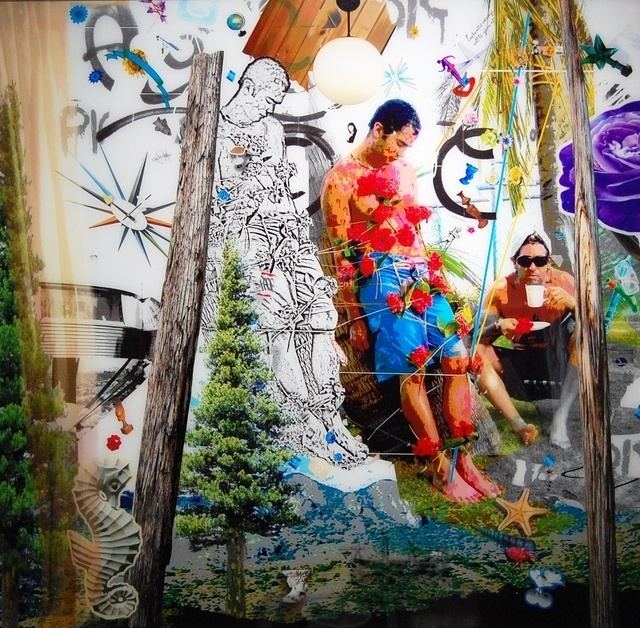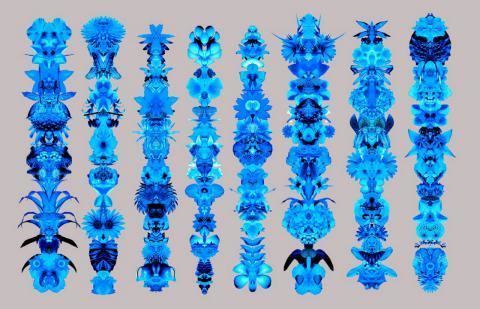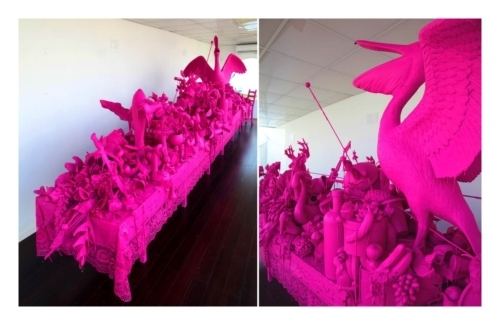Name Carlos Betancourt Role Artist | Education Miami Dade College | |
 | ||
Brief video on carlos betancourt s artworks circa 2000 2002
Carlos Betancourt (born March 18, 1966) is a Puerto Rican artist, generally described as influenced by the artworks of sensationalist, conceptualist and neo primitive artists, although his work defies specific categorization. Betancourt's oeuvre explores the kaleidoscope (multi- racial, multi-lingual, trans-cultural) of Caribbean and American culture. He is best known for his glitzy bravado, re-introducing glitter and other colored materials to contemporary art. His ways of bending the lines between art, photography and nature in his large format vinyls, photographs, installations and photo performances are considered innovative. In his multi- disciplinary artworks, Betancourt explores issues of memory and his own experiences, while also questioning matters of beauty, identity and communication. By means of re-examination, he recycles and reinterprets the past and delivers in a fresh relevant context. He bends the lines between art, photography, and nature in his multi-displinary work.
Contents
- Brief video on carlos betancourt s artworks circa 2000 2002
- Carlos betancourt golden pond wishes
- Life
- Imperfect Utopia
- References

He is inspired by his relationship with nature as well as Miami, Puerto Rico, Cuba, mid-century imagery and architecture and his extensive travels. Also by artist Ana Mendieta's interventions, Robert Rauschenberg's assemblages, Andy Warhol's perceptions, Neo Rauch compositions, and a Federico Fellini-esque cast of characters for his photo assemblages. He is also influenced by the work of Jean Baudrillard and his philosophy on objects; French artist Gustave Courbet's idea that "the only possible source for living art is the artist's own experiences", as well as the Martinican writer and theoretician, Edouard Glissant's belief that ..."the past resides in material objects that only release their hidden meanings when encountered imaginatively and sensuously". Other artists that have influenced his work include Fernando Oller, Bill Viola, Cisco Gimenez, Marilyn Minter, Cindy Sherman, Damien Hirst, Félix González-Torres, Jeff Koons and Arnaldo Roche.

Carlos betancourt golden pond wishes
Life

Betancourt's personal journey—physical, emotional, and intellectual—is the creative force behind his work. Born and raised in Puerto Rico to Cuban parents, he developed a love for nature, and a passionate interest in the mixing of cultures and traditions and the island's Taíno past. Like Puerto Rico, Betancourt's work is a syncretic layering of information against the intensity of the lush tropics. As a teenager, he moved to Miami where he saw the convergence of diverse architectural and design styles. He moved from San Juan, Puerto Rico with his parents to Miami, Florida on December 31, 1980. At an early age, he was a student of Jorge Rechany in his studio in San Juan. He attended high school in Puerto Rico at Colegio La Piedad (also in San Juan), as well as Miami Coral Park Senior High School. He studied architecture at Miami Dade Community College, and graduated from the Art Institute of Fort Lauderdale. He quickly became involved in art projects, volunteering in artist Christo's Surrounded Islands, which had a huge impact on him. Carlos Betancourt was part of an important group of early preservationist working with MDPL (Miami Dade Preservation League) that helped shaped the renaissance of Miami Beach in the 1980s. Together with his friends Barbara Capitman and Leonard Horowitz, he helped protect and preserved many Art Deco buildings in the now world famous and largest Art Deco district in the world. Sometimes the tactics included tying himself to some of the buildings, such as the Senator Hotel, that was eventually demolished. He is also involved in the preservation of mid-century architecture and his assistant during the Imperfect Utopia years, Terry D' Amico, also a preservationist, coined the term MiMo, for Miami Modernist Architecture. In the 1990s, he volunteered in the archeological site called the Miami Circle, an ancient Tequesta Indian site that was discovered in the mouth of the Miami River. Working with the preservation league as well as in the Miami Circle site had a big impact on his artwork. He is currently involved in the preservation of the mid-century Miami Marine Stadium.
Imperfect Utopia

His studio, Imperfect Utopia became the Bohemian underground address of the artistic melting pot that was Miami Beach in the 80's and 90's, challenging the established art community and provoking new ideas. The studio was visited by some of the most important artists, writers, poets, architects, dancers and musicians of the times, including Julian Schnabel, Sandra Bernhard, Gianni Versace, Morris Lapidus, Liz Balmazeda, Octavio Paz, Celia Cruz, Rudolph Nureyev and Bruce Weber. The juxtaposition of personalities and trans-culturalism that evolved during the Imperfect Utopia years and the Miami Beach renaissance provoked the artist to work in compositions loaded with collages and layering, blending and mixing, eventually creating his own syncretic world.
Imperfect Utopia is considered by many locals to be partly responsible for creating a contemporary arts environment in Miami and Miami Beach. During this period, the artist work on his concept of "Fracturism", which was based on his belief that we had an organic need to assemble and organize all personal experiences and information, which he believes it is the reason of our need for photo albums and documenting our existence. In part this was reflection of the shape and things to come, a prelude to the internet and social media era as well as iPhone cameras. His artwork continues to influence many contemporary artists locally and internationally. He continues to travel to Puerto Rico regularly where he finds continuous inspiration, particularly in the lushness of his land in el Yunque rainforest, where some of his most iconic artwork has been created.
|thumb|CBETANCOURT Casa Flamboyant III, 2010; print on fine art paper;
In October 2015, Carlos Betancourt: Imperfect Utopia was published by Skira/Rizzoli. Imperfect Utopia explores Betancourt's body of work with more than 250 images and text by critic Paul Laster, art history professor Robert Farris Thompson and United States inaugural poet, Richard Blanco. The artist has participated in several book signing in museums and institutions as well as dialogues with Richard Blanco, curator Bonnie Clearwater, and others.
Mr. Betancourt's artwork is part of public collections such as the Smithsonian' National Portrait Gallery in Washington, D.C., the Metropolitan Museum of Art in New York, the Fort Lauderdale Museum of Art, the Centro Atlantico de Arte Moderno in the Canary Islands, the Museo de Arte Moderno in Santo Domingo, San Antonio Museum of Art in Texas, PAMM Perez Art Museum, New Orleans Museum of Art, Palm Springs Arts Museum, the Bass Museum in Miami Beach, the Lowe Art Museum at the University of Miami, the Museum of Latin American Art in California, Museo de Arte de Ponce, etc., His work is exhibited in various galleries as well as art fairs such as Art Basel and Arco. He is the recipient of numerous awards and grants, including the Florida Department of State Millennium Cultural Recognition Award, a National Endowment for the Arts Grant, and the Miami Beach Arts Council Grant. He has worked as a curator, furniture designer and has collaborated in architectural and site specific commissions, collaborating with architect Alberto Latorre in several large scale public art commissions. Betancourt was co-founder of 801 Projects, an arts studio center that provides studio space for visual artists based in Miami.
